Зарядка аккумуляторов
Оптимальный ток зарядки аккумулятора определяется просто: он составляет 1/10 ёмкости аккумулятора (0.1 С). Т.е. если имеем аккумулятор ёмкостью 2000 мА/ч, то заряжать рекомендуется током 200 мА, если 2500 мА/ч, то, соответственно, оптимальный зарядный ток будет 250 мА и т.д. При ускоренной зарядке происходит нагрев (а иногда и перегрев) аккумуляторов, что приводит к ускоренному старению и уменьшению ёмкости. Поэтому покупать имеет смысл зарядку, в которой каждый аккумулятор заряжается отдельно от других, а не в батарее, и имеется функция разряда не до конца разряженных аккумуляторов, чтобы минимизировать потерю ёмкости со временем.
Методы заряда аккумуляторов
Существующие методы заряда NiCd и NiMH аккумуляторов можно разделить на 4 основные группы:
- медленный заряд – заряд постоянным током величиной 0.1 С в течение примерно 15 часов или 0.2 С в течение 6-8 часов
- быстрый заряд – заряд постоянным током, равным 1/3 С в течение примерно 3-5 часов
- ускоренный или дельта V заряд – заряд с начальным током заряда, равным величине номинальной ёмкости аккумулятора, при котором постоянно измеряется напряжение на аккумулятора и заряд заканчивается после того, как аккумулятор полностью заряжен. Время заряда примерно час–полтора.
Разделение это достаточно условно и зависит от фирмы-изготовителя аккумуляторов. Подход к вопросу о заряде аккумуляторов примерно такой: фирма разрабатывает различные типы аккумуляторов под различные применения и устанавливает для каждого типа рекомендации и требования по наиболее благоприятным методам заряда. В результате одинаковые по внешнему виду (размерам) аккумуляторы (одиночные элементы) могут потребовать применения различных методов заряда.
From Charger SkyRC MC3000:
Be careful with charge current, using anything below 0.3C will probably miss termination on AA/AAA cells. I mostly use the setting around 0.5C.
To keep the cells safe if the terminations is missed use a capacity limit between 130% and 150% of the cells capacity and a timer cutoff calculated as capacity/current×1.4, i.e. for a 2000mA cell at 1A it is 2000/1000*1.4 = 2.8 hours = 2 hours 48 minutes.
For NiMH the -dv/dt setting must be as low as possible, I used 3mV for my test, but a lower value might be even better. Too low value will not damage the cell, but might give early termination.
LSD cells do not need any trickle charge, for other cells a 10mA trickle charge can be used, but it not really needed either (some manufactures recommend a time limited trickle charge after a -dv/dt charge).
Official termination voltage for NiMH when discharging to measure capacity is 1 volt, but there is no problem going lower (like 0.8 volt).
With NiMH the cycle mode can be used to refresh cells that has been unused for some times.
LiIon
LiIon cannot really be over charged when the charger uses the correct voltage, but damage cells can do nasty things if the charger continues to charge them. Using the capacity and timer cut specification will reduce the risk of that.
Because LiIon do only need rated capacity when charged the safety limit can be place as low as 10% above the rating, but more is also acceptable. For 18650 I will be using 3600mAh and for 26650 7000mAh limits.
Time can be estimated as capacity/current+2 hours, i.e. for a 3400mAh cell at 1A it is 3400/1000+2 = 5.4 hours or 5 hours and 40 minute. The extra hours added will depend on cell age and termination current, two hours will work in most cases.
When discharging using 3V as “cut volt” is always safe, for lower voltage it is best to check the datasheet, but a single discharge to a lower voltage without using the “D.REDUCE” option will probably be safe (I have never seen any problems in my tests).
From SkyRC — IFA 2014 — MC3000 charger-analyzer
Время зарядки
| Тип | Ёмкость | Ток зарядки (мА) | Время зарядки (ч) |
|---|---|---|---|
| AA | 2600 | 260 | 16 |
| AAA | 200 | 120 | 16 |
“C” is the rated capacity of the battery in amp-hours. The datasheet subscript “5” usually means the time period used by the manufacturer to calculate C, so read C5 as “C over a 5 hour discharge time”.
See also:
Charger
- Умная зарядка Kweller X-1800. Заряжаем никель правильно – рассказывает также о принципах зарядки аккумуляторов
-
-
-
- HTRC B6 V2, смотрим что внутри, как работает – как подобрать блок питания (+12V для 3S, +18V для 4S), чтобы не поплавился штекер; +18.5V – это максимум, который допускает зарядка; DC→DC конвертер стабилизируется медленно от напряжения питания вниз
 , напряжение скачет
, напряжение скачет - iMAX B6 — Универсальный зарядочный комбайн – про подключение к PC через разъём термодатчика
- Charge: 60W / 6A max
- Discharge current: 5W / 1A max
- Balance current: 300mA max
- Power supply: 12V 5A (11V-18V)
- Battery types: LiPo / LiFe / Li-Ion / LiHV / NiMH / NiCd / Pb / DJI Mavic
- DC/DC converter
 External thermistor (to be attached to the battery)
External thermistor (to be attached to the battery)
 Does not calculate/show the total power delivered to the battery
Does not calculate/show the total power delivered to the battery
- ToolkitRC M6D 500W 15A
- Input: 7-28V @30A max
- Battery Type: LiPo / LiHV / LiFe / Lion @1-6S, NiMh @1-16S, Pb @1-10S
- Balance current: 800mA
- Charge/discharge: 0.1-15A / 250W on each channel
- USB: 5V @2.1A (used to upgrade firmware)
- Display: LCD IPS 2.4″ 320×240
- Size: 98×68×35mm
- Weight: 220g
-
- Input: DC XT60 5-30V @10A (240W max), USB-C PD3.1 5-28V @5A (100W max)
- Output: DC XT60 3-30V @0.5-10.0A (240W max)
- Battery Type: LiFe / LiPo / LiHv (4.35-4.50V) 1-6S / Pb 1-12S / NiMH 1-16S
- Balance current: 800mA
- Display: 1.5″ IPS LCD
- Size: 72.5×60×26.6mm
- Weight: 85g
- Working temperature: 0..40°C
Battery specifications
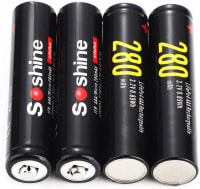 LiFePO4 AAA (10440) Soshine specification:
LiFePO4 AAA (10440) Soshine specification:
- Capacity (max/min): 280mAh / 200mAh
- Charge: standard 50mA, rapid 500mA to 3.6V, 60mA cut-off
- Max continuous discharge: 2A, 2.0V cut-off
- Emergency current cut-off: 1A
- Low resistant
- Size: 10×44mm (DxH)
- Weight: 7.5g
- IR (measured): 220-260mΩ
- 4 in all remotes (Sony TV IR remote + Pioneer remote + Kartina remote + Amazon Fire TV remote)
- 1 in digital torque adapter
- 1 in digital round kitchen scales
- 1 in infrared thermometer Mestek IR01D
- 1 not used
EBL AA 1100mAh + AAA 2800mAh:
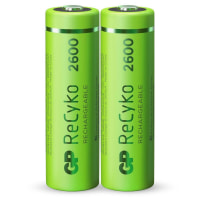 GP ReCyko+ AA 2600 2300mAh specification (website):
GP ReCyko+ AA 2600 2300mAh specification (website):
- Capacity (max/min): ~2300mAh
GP ReCyko+ AA 270AAHC 2600mAh specification:
- Capacity (max/min): 2600mAh / 2500mAh
- Charge:
- standard: 0.1C16 (250mA @16 hours)
- rapid 2500mA with Δ0..5mV cut-off
- Max continuous discharge: 7.5A, 0.9V cut-off
- Nominal voltage: 1.2V
- Size: 14.5×50.5mm (DxH)
- Weight: 31.5g
- IR: 18mΩ
- 5×2 = 10 – thermostates
- 2 in Natalia's trimmer
- 2 in New Year lights
- 6 not used
GP ReCyko+ AAA 100AAAHC 950mAh specification:
- Charge:
- standard: 0.1C16 (95mA @16 hours)
- 2 in remote control sticked to the wall for LED strips in kitchen
- 2 in multimeter VC99
- 2 in multimeter AN8009
- 2 in lazer meter Lomvum LV77U
- 2 in Madisana scales
Ultracell 400mAh 9V battery:
- Charge: 15mA 14.40V (not from spec / measured at charger)
- 1 in metal detector Lomvum LW10
- 1 in fire alarm on 2nd floor
- 2 not used
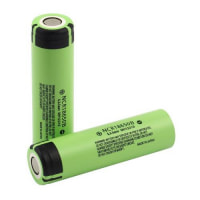 Panasonic NCR18650B LiIon specification:
Panasonic NCR18650B LiIon specification:
- Capacity (max/min): 3350mAh / 3250mAh
- Charge: 1625mA 4.20V @4 hours
- Max continuous discharge: 4.875A, 2.5V cut-off
- Nominal voltage: 3.5V
- Size: 18.5×65.3mm (D×H)
- Weight: 48.5g
- IR: <100mΩ
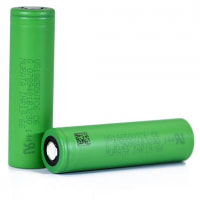 Sony Murata US18650VTC6 LiIon specification:
Sony Murata US18650VTC6 LiIon specification:
- Capacity (max/min): 3120mAh / 3000mAh
- Charge: 3A 4.20V @2.5 hours
- Continuous/max discharge: 20A / 80A, 2.5V cut-off
- Nominal voltage: 3.6V
- Size: 18.45×65mm (D×H)
- Weight: 47g
- IR: 12.8mΩ
- Price: €3.95 (2020-06-28)
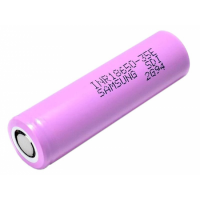 Samsung INR18650-35E specification:
Samsung INR18650-35E specification:
- Capacity (max/min): 3450mAh / 3500mAh
- Charge: 0.5C = 1700mA 4.2V, 0.02C (68mA) cut-off
- Continuous/max discharge: 8A / 13A, 2.65V cut-off
- Nominal voltage: 3.6-3.7V
- Size: 18.55×65.25mm (D×H)
- Weight: 48g
- IR: <35mΩ
- Price: €3.45 (2022-07-04)
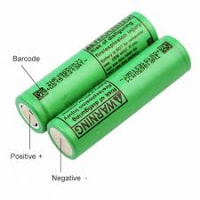 LG INR18650-MJ1 specification:
LG INR18650-MJ1 specification:
- Capacity (max/min): 3400mAh / 3500mAh
- Charge: 0.5C = 1700mA 4.2V, 50mA cut-off
- Continuous/max discharge: 680mA / 10A, 2.5V cut-off
- Nominal voltage: 3.635V
- Size: 18.4×65mm (D×H)
- Weight: 49g
- IR: <40mΩ
- Price: €3.69 (2024-03-21)
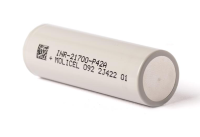 Molicel INR-21700-P42A specification:
Molicel INR-21700-P42A specification:
- Capacity (max/min): 4200mAh / 4000mAh
- Charge: 1C = 4.2A 4.2V
- Max discharge: 45A, 2.5V cut-off
- Nominal voltage: 3.6V
- Size: 21.7×70.2mm (D×H)
- Weight: 70g
- IR: <16mΩ
- Price: €4.55 (2024-03-21)
- Capacity: 1050mAh
- Charge: 525mA for 3.5h min
- Discharge: 210mA to 2.75V (discharge with 0.3A takes 02:46)
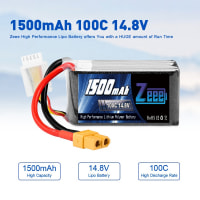 Zeee 4S 14.8V 1500mAh 100C LiPo battery:
Zeee 4S 14.8V 1500mAh 100C LiPo battery:
- Capacity: 1500mAh
- Voltage: 14.8V
- Configuration: 4S1P
- Discharge rate: 100C
- Charge rate: 0.5C..1C
- Connector type: XT60
- Balancer connector type: JST-XH
- Dimensions (W×D×H): 35×33×67mm
- Weight: 168g
- To store for a long time, discharge the battery to 50% (3.8V per cell)
- Never store the battery fully charged, the performance will degrade noticeably
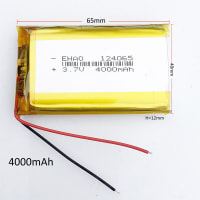 124065 3.7V 4000mAh LiPo battery:
124065 3.7V 4000mAh LiPo battery:
- Voltage: 3.7V
- Discharge rate: 1C
- Fast charging: 1C
- Standard charging: 0.5C CC to 4.25V, then CV till charge current is less than or equal to 0.05C
- Termination current: 0.05C
- Discharge cut-off voltage: 2.75V
- Dimensions (H×W×L): 12×40×65mm
- 2021-06-16: SkyRC: LiIon 3764mAh
- 2021-11-30: iMax: LiIon 0.5A: 879mAh
Links
- Best 18650 Battery (local copy (1.86 MiB, 238 downloads))
- Alkaline, lithium and zinc-chloride cells test to find the best AA batteries you can buy for your money
-
- Батарейки и мороз – хранение на морозе почти не вредит щелочным батарейкам, за год хранения ёмкость щелочных батареек не уменьшается
-
List of battery sizes from which most popular are:
- For D-size battery use D Size Battery Converter (for two AA accumulators).
"Девица не хочет лезть в Окно" – device not compatible with Windows.
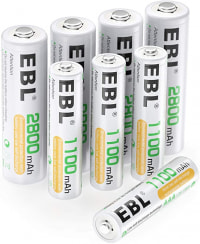
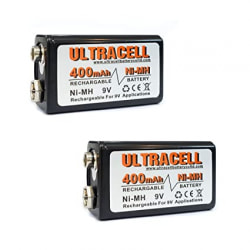
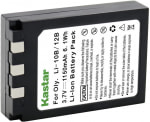
 Good:
Good: